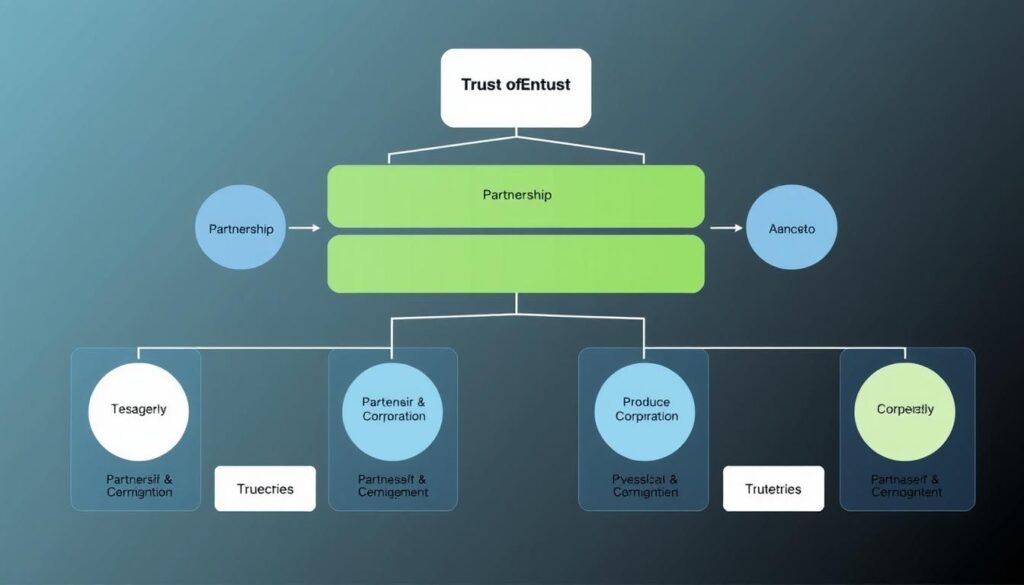What Is Portfolio Investment Entity? I’ve always looked for ways to grow my investments safely. That’s why Portfolio Investment Entities (PIEs) caught my eye. They offer tax benefits, expert management, and spread out your investments. This sounds like a dream come true for investors like me.
But what are PIEs, and how can they help you? Let’s explore this powerful tool together.

Key Takeaways
- PIEs offer tax advantages compared to regular individual tax rates in certain jurisdictions.
- PIEs provide diversification by investing in a range of asset types and sectors, reducing individual investment risks.
- PIEs grant investors access to professional management, market expertise, and analytical tools to enhance investment decisions.
- PIEs operate under regulatory oversight to ensure transparency and investor protection.
- Understanding the unique characteristics of PIEs empowers you to make informed investment choices aligned with your financial goals.
Understanding Portfolio Investment Entities (PIEs)
Portfolio Investment Entities, or PIEs, are special investment groups. They collect money from many investors to create diverse portfolios. These groups can be companies, trusts, or superannuation schemes. They offer investors a wide range of passive investments.
Basic Definition and Structure
PIEs are at the heart of investing. They pool money from investors into various passive investments like stocks and bonds. The most common PIE is the multi-rate PIE (MRP). Here, investors choose their tax rate, and the MRP taxes their income accordingly.
Key Features of PIEs
- Pooled investment approach, allowing for greater diversification and risk mitigation
- Access to professional fund management expertise
- Tax efficiency, as capital gains within PIEs are typically taxed at lower rates
- Transparency and regulatory oversight to protect investor interests
Regulatory Framework
PIEs follow strict rules to ensure fairness and transparency. These rules help protect investors. PIEs are regularly checked to make sure they follow these guidelines.
| Key Regulatory Aspects of PIEs | Description |
|---|---|
| Disclosure Requirements | PIEs must give investors clear info on their strategies, fees, and risks. |
| Reporting Obligations | PIEs must report their finances and performance regularly to authorities and investors. |
| Investor Protection Measures | Rules make sure PIEs treat investors fairly and manage risks well. |
Knowing about PIEs helps investors make smart choices. It’s key to understanding them when planning your portfolio investment strategy.
What Is Portfolio Investment Entity and Its Core Functions
A Portfolio Investment Entity (PIE) is a financial tool that manages many assets for its investors. It collects money from different investors and puts it into various investments like stocks, bonds, mutual funds, and ETFs. PIEs aim to balance risks and rewards by spreading investments.
They offer professional management, helping investors gain from experienced fund managers.
The main roles of a Portfolio Investment Entity include:
- Pooling resources from multiple investors
- Spreading the money across a wide range of investment strategies and asset classes
- Providing expert portfolio management services to investors
- Trying to get the best returns while managing risks through smart asset allocation
- Offering tax benefits and following rules for investors
PIEs let investors tap into many investment chances that might be hard to manage alone. This way, investors can enjoy the benefits of a diversified portfolio management while reducing risks with professional help.
“Portfolio Investment Entities play a crucial role in channeling investment capital into a wide array of financial instruments, offering investors the potential for enhanced returns through professional management and diversification.”
Benefits of Investing in Portfolio Investment Entities
Investing in Portfolio Investment Entities (PIEs) comes with many benefits. They offer tax advantages, professional management, and risk diversification. These features make PIEs a great choice for investors today.
Tax Advantages
One key benefit of PIEs is their tax advantages. They have a tax rate cap of 28%, which is lower than the top personal tax rate. This means investors can keep more of their earnings.
For example, someone with a taxable income of $14,000 can get a 10.5% tax rate in a PIE fund. This saves them $350 compared to regular taxes. Also, those with up to $70,000 in income can get a 17.5% tax rate, saving $625.
Professional Management
PIEs give investors access to skilled fund managers. These managers use their knowledge and tools to make smart investment choices. They aim to increase returns for investors.
Octagon, a top investment firm, offers PIE-compliant funds. These include New Zealand and Australian Equities, Listed Property, and Global Equities. Investors benefit from the managers’ insights and risk management.
Risk Diversification
PIEs also help with risk diversification, a key investment strategy. By investing in different assets and sectors, PIEs reduce risk. This can lead to more stable and consistent returns over time.
Kate, with a taxable income of $48,000, pays only 10.5% tax on her PIE fund returns. This is a big drop from the usual 33% tax rate. It lets her save more and grow her investments better.
In summary, PIEs offer tax benefits, professional management, and risk diversification. These features make PIEs a great choice for investors looking to improve their strategies and returns.
Types of Portfolio Investment Entities
Portfolio investment entities (PIEs) come in many types, each with its own strengths and tax rules. You can find mutual funds, Exchange-Traded Funds (ETFs), hedge funds, unit trusts, and investment trusts. Knowing the differences between these can guide your investment choices.
Mutual funds are a favorite because they mix money from many investors into a single portfolio. This way, they aim to reduce risk and increase returns. ETFs, however, are traded like stocks and offer a way to invest in a specific market or sector.
Hedge funds seek high returns with bold strategies but come with higher risks. Unit trusts show investors’ stakes through “units.” Investment trusts, on the other hand, are closed-end funds traded on stock exchanges.

Each PIE has its own benefits, tax rules, and features. Think about your investment goals, how much risk you can take, and the characteristics of each structure. This will help you pick the right one for your portfolio.
“Diversifying your investments across different types of PIEs can be a strategic way to manage risk and optimize your returns.”
Remember, the tax rules and regulations for these entities can change. Always talk to financial and legal experts. They can help you understand the tax implications and make sure you follow the law.
How PIE Tax Rates Work
Portfolio Investment Entities (PIEs) face specific tax rates, called Prescribed Investor Rates (PIRs). These rates depend on an investor’s personal tax situation. For New Zealand tax-resident individuals, the rates are 10.5%, 17.5%, and 28%.
Investors must give their Inland Revenue Department (IRD) number and correct PIR to the PIE. The PIE then calculates and pays the tax for the investor. If the PIR is wrong, the default rate of 28% is used.
Tax Calculation Methods
Multi-rate PIEs (MRPs), like KiwiSaver schemes, need investors’ IRD number and PIR. Without this info in 6 weeks, the account might be closed. When leaving a Multi-rate PIE, investors might get a 0% tax rate.
If the PIR is wrong, any mistakes will be fixed during the tax year assessment. This will show as a PIE debit or credit. Remember, PIE income from locked-in funds, like KiwiSaver, doesn’t count for Working for Families Tax Credits or student loan repayments.
Annual Tax Reporting
PIEs must give annual income details to investors by certain deadlines. Investors should keep records for at least 7 years in some cases. Non-resident tax residents use a 28% PIR, while tax residents include worldwide income for PIR calculations.
| Prescribed Investor Rate (PIR) | Tax Rate |
|---|---|
| 0% | 0% |
| 10.5% | 10.5% |
| 17.5% | 17.5% |
| 28% | 28% |
It’s key for investors to grasp the details of PIE tax rates and reporting. This ensures they get the most tax benefits and meet their investment obligations.
Investment Strategies in PIE Funds
PIE funds offer a wide range of strategies for investors. These investment strategies focus on making consistent returns. They also emphasize portfolio management and smart asset allocation.
PIE funds, like the Octagon Investment Funds, provide many investment choices. They include New Zealand and Australian equities, global equities, fixed-interest securities, and listed property. This mix helps reduce risk and lets investors benefit from different market conditions.
PIE funds use either active or passive strategies. Active management means fund managers make choices based on market analysis. They try to beat certain benchmarks. Passive management tracks a market index, offering a cost-effective and low-risk way to build a portfolio.
“The key to successful investing is not picking the right stocks, but rather building the right portfolio.”
The right investment strategy depends on the investor’s risk level, time horizon, and goals. By knowing the investment strategies in PIE funds, investors can choose wisely. This helps align their portfolios with their long-term financial goals.
PIE funds also offer tax benefits, making them more attractive to investors. Keeping up with PIE investment trends and rules helps investors optimize their portfolios. This can lead to better returns.
Risk Management in Portfolio Investment Entities
Investing in a Portfolio Investment Entity (PIE) can protect your money. These vehicles pool funds from many investors. This way, they spread your risk across different assets and sectors.
Diversification Techniques
PIEs invest in a mix of assets like stocks, bonds, and mutual funds. This mix helps lower the risk of losing money. By spreading investments, fund managers aim to balance risk and return.
Market Risk Mitigation
PIEs use strategies to reduce market risk. They might use derivatives or adjust investments based on market trends. This helps protect your money and provides stable returns over time.
Portfolio Rebalancing
Regular rebalancing is key in PIEs. As markets change, the fund’s mix might shift. Rebalancing keeps the investment mix on track, managing risks and potentially boosting returns.
PIEs use these strategies to build a strong investment portfolio. They aim to keep your money safe and provide a stable, diversified investment experience.
Choosing the Right PIE Investment
Investing in portfolio investment entities (PIEs) is key to reaching your financial goals. PIEs offer many options, like trusts, mutual funds, and ETFs. Each has its own benefits and features.
When picking a PIE, look at its strategy, past performance, fees, and tax benefits. Reading the Product Disclosure Statements for PIEs like Octagon Investment Funds and the Summer KiwiSaver scheme can give you insights. This helps you understand their investment approach and risk level.
Talking to a financial advisor is also wise. They can help match your investment with your financial goals and risk level. They know which types of investment entities fit your needs best.
What works for one investor might not work for you. So, it’s important to think about what you need and want. By researching and understanding the different PIE options, you can make a smart choice. This could help you get better returns on your investment.
| Key Considerations for Choosing the Right PIE | Potential Benefits |
|---|---|
| Investment strategy Historical performance Fees and expense ratios Tax efficiency Management team qualifications | Alignment with personal financial goals Diversification and risk management Potential for higher risk-adjusted returns Simplified tax reporting and compliance Access to professional investment management |
By carefully looking at these factors and getting advice, you can choose the portfolio investment entity that fits your needs. This ensures your investments align with your goals and risk tolerance.

“Choosing the right PIE investment is not just about maximizing returns, but also about aligning your investments with your personal financial goals and risk tolerance.”
Legal and Regulatory Compliance
Portfolio Investment Entities (PIEs) follow strict rules to protect investors and keep the market fair. They have strong governance, reporting rules, and safety measures. This makes sure they follow all laws and rules.
Governance Structure
PIEs have a clear governance setup. This includes a board of directors that oversees the fund. They make big decisions, check for compliance, and talk openly with investors.
Reporting Requirements
PIEs must report to both investors and regulators. They give investors yearly updates on income, holdings, and performance. They also share information with financial regulators regularly. This keeps everything transparent and in line with standards.
Investor Protection Measures
Keeping investors safe is key for PIEs. They follow strict rules on being open, fair pricing, and following guidelines. Investors in PIEs get strong protection. Regulatory bodies watch over the industry to make sure rules are followed.
Also Read: Program-Related Investment
FAQ
What are the key features of PIEs?
PIEs are entities that invest in different types of passive investments. They can be companies, trusts, or superannuation schemes. The most common type is a multi-rate PIE (MRP).
Investors notify the MRP of their prescribed investor rate (PIR). The MRP then attributes income to the investor and calculates PIE tax using the investor’s PIR.
What are the benefits of investing in PIEs?
Investing in PIEs offers several benefits. These include tax advantages, access to professional management, risk diversification, and good liquidity. Tax advantages include a cap on tax rates at 28% compared to the top personal marginal tax rate of 39%.
Professional management provides access to expert fund managers with in-depth market knowledge and analytical tools.
What are the different types of Portfolio Investment Entities?
There are several types of PIEs, each with different abilities and tax requirements. These include mutual funds, Exchange-Traded Funds (ETFs), hedge funds, unit trusts, and investment trusts. Mutual funds pool money from several investors to invest in a diversified portfolio.
ETFs are traded on stock exchanges like individual stocks. Hedge funds aim for high returns but are riskier and less regulated.
How do PIE tax rates work?
PIE tax rates are based on Prescribed Investor Rates (PIR). There are four rates: 0%, 10.5%, 17.5%, and 28%. Investors need to provide their IRD number and correct PIR to the PIE.
The PIE calculates and pays tax on the investor’s behalf. If the advised PIR is lower than the correct rate, the investor may need to pay any tax shortfall.
What investment strategies do PIE funds employ?
PIE funds employ various investment strategies to achieve their objectives. They diversify across different asset classes, sectors, and geographical regions. Some PIEs cover sectors including New Zealand equities, Australian equities, global equities, fixed interest, and listed property.
Investment strategies may also involve active management or passive management.
How do PIEs manage risk?
PIEs employ various risk management techniques to protect investors’ capital. Diversification is a key strategy, spreading investments across different asset classes and sectors to mitigate the impact of poor performance in any single investment.
Market risk mitigation may involve using hedging strategies or adjusting asset allocation based on market conditions. Portfolio rebalancing is regularly performed to maintain the desired asset allocation and risk profile.
How do I choose the right PIE investment?
Choosing the right PIE investment depends on individual financial goals, risk tolerance, and investment horizon. Investors should consider factors such as the PIE’s investment strategy, historical performance, fees, and tax efficiency.
It’s important to review the Product Disclosure Statements for PIEs and consult with a financial adviser to make informed decisions aligned with personal financial objectives.
What is the legal and regulatory framework for PIEs?
PIEs operate under specific legal and regulatory frameworks to ensure investor protection. They have governance structures in place, often including a board of directors responsible for safeguarding shareholders’ interests.


